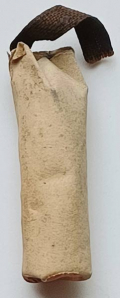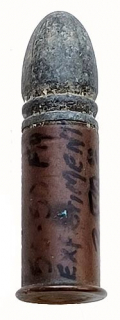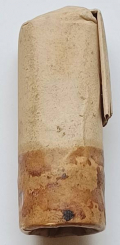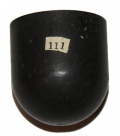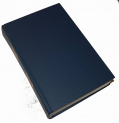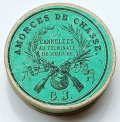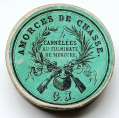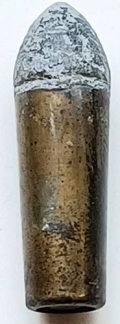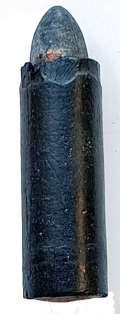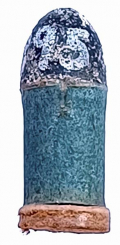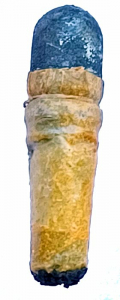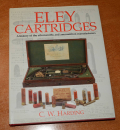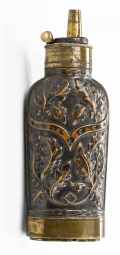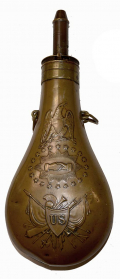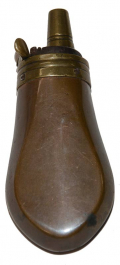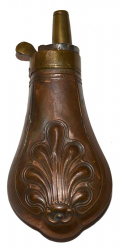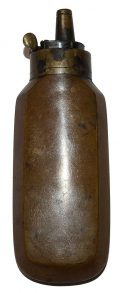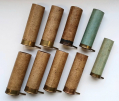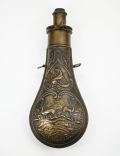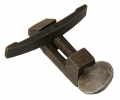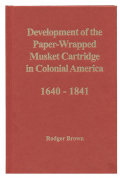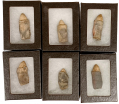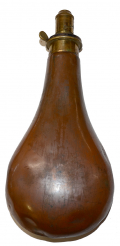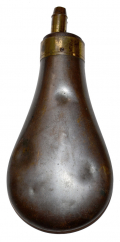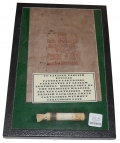site search
online catalog
Cartridges & Gun Tools
Showing 51 to 100 out of 108
.36 CALIBER (84 GUAGE) ENGLISH REVOLVER CARTRIDGE IN ENVELOPE – ELEY, LONDON
Perfect example of a hard-to-find cartridge. This fine specimen is still encased in its protective outer wrapper, with orange label, and brown cloth pull tab. Many English revolvers from Adams, Kerr,… (1212-112). Learn More »
VERY RARE .50-50 EXPERIMENTAL CARTRIDGE – FRANKFORD ARSENAL
This is a .50 caliber copper rimfire cartridge. One of many profiles and sizes experimented with at the Frankford Arsenal following the Civil War. The search was for the most appropriate bullet,… (1212-146). Learn More »
ENGLISH PERCUSSION CAP PACK
This is a “pulp bag” of percussion caps as manufactured at the Royal Laboratory at Woolwich, England. Each pack was to contain 15 copper percussion caps. Packages are full of caps and twisted… (2023-2737). Learn More »
.69 CALIBER POWDER CHARGE – GRAY PAPER
This powder charge is in very good condition. Measures 2” long. Fine gray cartridge paper is tied closed at both ends, however there is also a typical folded tail. A blank musket charge that could… (1212-176). Learn More »
18MM (~.70 CALIBER) CARTRIDGE FOR ALTERED SWISS RIFLES
This cartridge is in excellent condition. Measures 1.9” long. Lubricated over bullet with end tucked into the bullet cavity. These “expanding ball” cartridges were for the Swiss Model 1842… (1212-184). Learn More »
POWDER MEASURE ONCE OWNED BY J. HOWARD WERT
Made of tin this unusual item is listed in Wert’s catalog as a powder measure. It measures 1 5/8 inches deep with a rounded bottom and is 1 ¼ inches in diameter. It has the catalog number 111 on… (224-796). Learn More »
POWDER MEASURE ONCE OWNED BY J. HOWARD WERT
Made of tin this unusual item is listed in Wert’s catalog as a powder measure. It measures 1 ¾ inches deep with a rounded bottom and is 1 1/2 inches in diameter. It has the catalog number 111 on… (224-795). Learn More »
BOOK – SPECIFICATION AND DRAWINGS OF CARTRIDGES FOR SMALL ARMS, PATENTED IN THE UNITED STATES PRIOR TO JANUARY 1, 1878
This is a reprint of the original 1878 edition that was in the collection of Herschel Logan. A high-quality reprint from Armory Publications. 7.5” x 11” x 2.5”, unpaginated. Approximately 300… (236-724). Learn More »
PASTEBOARD PACKAGE OF FRENCH PERCUSSION CAPS
Here is a very nice French pasteboard percussion cap container, unopened and full of caps. Round package made of white pasteboard with green paper labels affixed. A white paper label was pasted along… (1212-250). Learn More »
PASTEBOARD PACKAGE OF FRENCH PERCUSSION CAPS
Here is a very nice French pasteboard percussion cap container, unopened and full of caps. Round package made of white pasteboard with green paper labels affixed. A white paper label was pasted along… (1212-210). Learn More »
THUER’S PATENT .36 CALIBER “POCKET NAVY” CARTRIDGE
This is a Thuer’s Patent metallic centerfire cartridge. This short .36 caliber cartridge is in excellent original condition and was for the Colt Thuer conversion “Pocket Navy” revolver. These… (1212-24). Learn More »
REPRODUCTION SET OF CRISPIN CARTRIDGES
This is a cased display set of reproduction Crispin cartridges as given out at the 2005 California Cartridge Collectors Show. Foam-filled plastic case holds five different Crispin cartridges made for… (1212-251). Learn More »
VERY RARE .36 CALIBER SMITH “RUBBER CASE” CARTRIDGE
Gilbert Smith of Buttermilk Falls, NY, received patent #17,702 in June of 1857 for his invention of a cartridge case made of India rubber. All should be familiar with the .50 caliber Smith carbine… (1212-181). Learn More »
90-BORE (~.36 CALIBER) SHARPS “SPORTING RIFLE” CARTRIDGE
This style of cartridge was originally made prior to the Civil War and eventually replaced in the North by the “New Model” linen cartridges. However, the simple method of just tying the plain… (1212-87). Learn More »
60-BORE (~.44 CALIBER) SHARPS CARTRIDGE, GOMEZ & MILLS PATENT
Here is a very rare 60-Bore Sharps cartridge with a multi-groove bullet by Gomez and Mills. This cartridge is in fine condition. The paper is crisp, and you can clearly see where another cartridge… (1212-85). Learn More »
VERY RARE .36 CALIBER MARSTON PISTOL CARTRIDGE
U.S. patent #8956 was granted to William W. Marston & Frederick Goodell on May 18, 1852 for this cartridge. It was intended to be used in a breech-loading single shot firearm of Marston's design,… (1212-226). Learn More »
VERY RARE .36 CALIBER SAVAGE “SKIN” CARTRIDGE
Scarce .36 caliber Savage cartridge for Navy revolvers. Here is a cartridge that is rarely offered for sale in this fine condition. This style of cartridge was made by D.C. Sage of Middletown, CT.… (1212-114). Learn More »
COPY OF “ELEY CARTIDGES” FROM THE LIBRARY OF THE LATE DEAN S. THOMAS
The full title of this volume is “ELEY CARTRIDGES: A HISTORY OF THE SILVERSMITHS AND AMMUNITION MANUFACTURERS” by C. W. Harding and published by Quiller Press of Wykey, Shrewsbury, England in… (236-469). Learn More »
ELEGANT DOUBLE COMPARTMENT PISTOL POWDER FLASK
This small pistol flask is embossed with an attractive pair of oak leaf and acorn clusters in the top quarter, below which a long, thin, scrolling chevron with dots separates it from a pair of knotted… (490-5380). Learn More »
1849 DATED MEXICAN WAR ERA BATTY “PEACE” POWDER FLASK
Brass powder flask in good condition. The body has one small ding at bottom with a small seam opening. The decoration on the flask consists of a spread-winged eagle above a circle of 20 five-pointed… (160-170). Learn More »
SMALL PISTOL POWDER FLASK
This is very small powder flask, possibly of European manufacture and perhaps made on contract for an American retailer, intended for a pocket revolver or small single shot pistol. Measures… (490-5248). Learn More »
SMALL PISTOL POWDER FLASK
This is very small powder flask, possibly of European manufacture and perhaps made on contract for an American retailer, intended for a pocket revolver or small single shot pistol. Measures… (490-5247). Learn More »
BULLET MOLD FOR .31 CALIBER REVOLVER
Iron, two cavity bullet mold for the .31 caliber revolver. It casts one round ball and one elongated bullet. There is no sprue cutter. Cavities remain clean and crisp. There are several small dings on… (490-4365). Learn More »
BULLET MOLD FOR .31 CALIBER REVOLVER
Iron, two cavity bullet mold for the .31 caliber revolver. It casts one round ball and one elongated bullet. There is no sprue cutter. There are several small dings on exterior where the mold needed… (490-4364). Learn More »
BULLET MOLD FOR .31 CALIBER (120 GAUGE) ADAMS REVOLVER
Brass, two cavity bullet mold for 120 gauge (approx. .31 caliber) English Adams revolver. It casts two elongated bullets. These feature a pointy nose, two grooves, and a solid base. Iron sprue cutter… (490-4378). Learn More »
M-1855 MAINSPRING VISE FOR CONVERSION MUSKETS
Mainspring vise for the many types of early muskets that were converted to percussion ignition. Typical vise mechanism with offset bar to accommodate the older flintlock mainsprings. Excellent… (490-4363). Learn More »
PLAIN PISTOL POWDER FLASK
Constructed with plain copper body and brass top. Funnel unscrews and spring still works. Measures approximately 4.5" tall x 1.5" wide x 1" thick. All surfaces are unadorned, with sides that have… (490-4416). Learn More »
BULLET MOLD FOR .45 CALIBER, COLT M1878 REVOLVER
Iron, two cavity bullet mold for the .45 caliber Colt Model 1878 revolver. It casts two elongated bullets with grooves. These are the “.45 Long Colt” bullets. Sprue cutter is attached to the top… (490-4399). Learn More »
M-1855 MAINSPRING VISE FOR CONVERSION MUSKETS
Mainspring vise for the many types of early muskets that were converted to percussion ignition. Typical vise mechanism with offset bar to accommodate the older flintlock mainsprings. Excellent… (490-4380). Learn More »
BULLET MOLD FOR .44 CALIBER, COLT ARMY OR "HOLSTER" REVOLVER
Iron, two cavity bullet mold for the .44 caliber Colt Army revolver. It casts one round ball and one elongated bullet. Sprue cutter is attached to the top and is marked "COLT'S / PATENT". Cavities… (490-4376). Learn More »
COMPARTMENTED POWDER FLASK FOR THE AMERICAN MARKET, LIKELY FOR A CASED PAIR OF PHILADELPHIA DERRINGERS
This powder flask was certainly made for the American market. The bottom is fitted with two small, round hinged covers for interior compartments, each with an eagle with raised wings, a U.S. shield on… (30-2245). Learn More »
$575.00
Originally $695.00
RARE BULLET MOLD FOR .31 CALIBER "WELLS FARGO" M-1849 COLT REVOLVER
Very rare iron, two cavity bullet mold for the .31 caliber "Wells Fargo" Colt revolver. It casts one round ball and one elongated bullet. There is no sprue cutter. Marked "COLT'S / PATENT" across the… (490-4400). Learn More »
LOT OF PINFIRE SHOTGUN CARTRIDGES
Offered here is a lot of nine pinfire shotgun cartridges. One is loaded, all others are unused, empty shells waiting to be filled. The one loaded shell has raised “ELEY LONDON / 12 / 1861” on the… (M23280). Learn More »
DIXON & SON MARKED POWDER FLASK
This is a pretty powder flask with an adjustable spout and brown lacquered body impressed with a basket weave design on the faces and leaves curling up on either edge, with small brass suspension… (1184-74). Learn More »
HAWKSLEY MARKED POWDER FLASK
Good condition, plain body powder flask with prominent edge seam and adjustable spout measured in drams. Stamped “G.& J.W. HAWKSLEY / SHEFFIELD” on the top of the collar. Constructed with… (1184-71). Learn More »
HINGED CLIP WITH TWO .56 CAL. BILLINGHURST & REQUA CARTRIDGES
Offered here is a rare hinged clip for the Billinghurst-Requa Battery Gun. This is a 36” long piece that was made to hold 25 cartridges at once. Its condition is good with only some light surface… (2022-2886). Learn More »
$975.00
SOLD
TOMPION FOR BURNSIDE CARBINE
A wood tompion for a cavalryman’s .54 caliber Burnside carbine. This has the characteristic ball top, pointed tip, and cruciform slotted body of the Burnside tompions. They are occasionally seen in… (490-3945). Learn More »
HAWKSLEY POWDER FLASK
This has a wonderful profusion of design elements that seems to combine rococo foliate C-scrolls symmetrically arranged with some geometric ornaments- something in the “too much is not enough”… (1184-75). Learn More »
HAWKSLEY POWDER FLASK
A nicely decorated sportsman’s powder flask decorated in two panels with a hunting dog at top and the hunter’s prey at bottom: two stags with prominent antlers standing over a row of five less… (1184-73). Learn More »
US MODEL 1855 MAINSPRING VICE
Tool used for removing the mainspring from the lock. Very good condition. Operates properly. [ad] [PH:L] ~~~~~~~~~~~~~~~~~~~~~~~~~~~~~~~~~~~ THIS ITEM, AS WITH ALL OTHER ITEMS AVAILABLE ON OUR WEB… (179-1173). Learn More »
$93.00
ON HOLD
DEVELOPMENT OF THE PAPER-WRAPPED MUSKET CARTRIDGE IN COLONIAL AMERICA, 1640-1841
Brown, Rodger. 2022. Hardback, 6 x 9 ¾”. 96 pages; numerous b&w photos and illustrations. During the Revolutionary War, both armies in the conflict were armed with muzzleloading smoothbore… (ST501205). Learn More »
SMALL HUNTER’S POWDER HORN
This horn dates roughly 1820-1850. It is a plain, working powder horn only about 5 ¼ inches long, a size sometimes thought to be just for priming powder for a flintlock, but convenient enough to be… (1184-79). Learn More »
SMALL HUNTER’S POWDER HORN
This horn dates roughly 1820-1850. It is a plain, working powder horn only about 5 3/4 inches long, a convenient size for pocket or hunting bag. Sometimes considered a small horn just for priming… (1184-77). Learn More »
“DUG” .50 CALIBER SMITH “RUBBER CASE” CARTRIDGES
Used in the Smith carbine extensively during the early years of the Civil War, we have several specimens of these unusual .50 caliber “rubber case” cartridges in excavated “relic”… (2022-1238). Learn More »
SYKES MARKED FLASK FOR POCKET OR MUFF PISTOLS
This small copper and brass flask is in near mint condition with a very pleasing brown lacquer tone to the copper body, medium untouched patina to the brass collar and spout, and vibrant blue to the… (30-2246). Learn More »
WOODEN CRATE FOR SHARPS CARBINES DATED AUGUST 1876
Wooden shipping crate for 10 sharps carbines. Crate is missing the lid but is marked on one end with a clear date of “AUGUST 1876.” The same edge has some faint markings that look to read “10… (172-5755). Learn More »
.45 CALIBER IRON PISTOL BALL MOLD & BARREL TOOL
Iron scissor-type mold to cast a lead round ball for revolvers. Measures approximately 3.5” long overall. Single cavity mold with spout. Sprue cutter is formed between the two handles. Cavity… (1164-46). Learn More »
VERY LARGE POWDER FLASK BY J. DIXON & SONS, SHEFFIELD
This very large flask has to have been for shotguns. Constructed with a copper body, with brass top and spout. Measures approximately 11” tall x 5” at widest point. Unadorned body. Thumb tab and… (172-5639). Learn More »
POWDER FLASK FOR REVOLVERS
This flask is for early pocket model revolvers. Constructed with a copper body, with brass top and spout. Measures approximately 6” tall x 2.75” at widest point. Both sides are plain. Thumb tab… (172-5638). Learn More »
.577 CALIBER ENGLISH ENFIELD PATTERN CARTRIDGE
Fabricated by Ludlow Brothers of Birmingham, England. Nice display in a 8.25” x 12.25” Riker case. Photocopy of an original wrapper at top with info sheet below, and then the cartridge at the… (M24055). Learn More »
Showing 51 to 100 out of 108
Most Popular
Historical Firearms Stolen From The National Civil War Museum In Harrisburg, Pa »
Theft From Gravesite Of Gen. John Reynolds »
Selection Of Unframed Prints By Don Troiani »
Fine Condition Brass Infantry Bugle Insignia »
British Imported, Confederate Used Bayonet »
Scarce New Model 1865 Sharps Still In Percussion Near Factory New »
featured item
SCARCE 1859 DATED AMES LIGHT CAVALRY SABER, AKA MODEL 1860
Old habits die hard. Although we now know production of the new pattern cavalry saber intended to replace the heavy Model 1840 started in 1857, most still refer to them as the Model 1860. This is a scarce example of one produced by Ames in 1859 and… (2022-718). Learn More »



